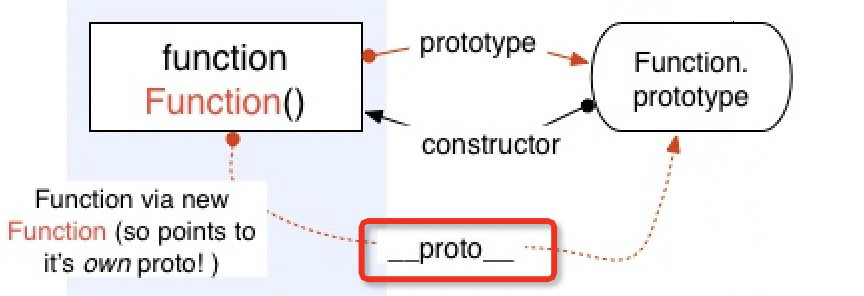- 1. 从JS创建一个对象开始说起:
- 2. 原型模式
- 3. 原型链继承
- 4. Funtion.proto === Function.prototype
- “所有的函数都有prototype属性”。这句话其实是错误的。Function.prototype就是一个函数,但是这个函数并没有prototype属性。
- 2022-03-01 额外总结
1. 从JS创建一个对象开始说起:
1.1 工厂模式创建对象 (缺点是无法知道创建出来的对象是一个什么类型的对象)
function createPerson(name, age, job) {
let o = new Object();
o.name = name;
o.age = age;
o.job = job;
o.sayName = function() {
console.log(this.name);
};
return o;
}
let person1 = createPerson("Nicholas", 29, "Software Engineer");
let person2 = createPerson("Greg", 27, "Doctor");
1.2 构造函数创建对象
function Person(name, age, job){
this.name = name;
this.age = age;
this.job = job;
this.sayName = function() {
console.log(this.name);
};
}
let person1 = new Person("Nicholas", 29, "Software Engineer");
let person2 = new Person("Greg", 27, "Doctor");
person1.sayName(); // Nicholas
person2.sayName(); // Greg
console.log(person1.constructor == Person); // true
console.log(person2.constructor == Person); // true
console.log(person1 instanceof Person); // true
console.log(person2 instanceof Person); // true
console.log(person1.sayName == person2.sayName); // false
优点:没有显示创建对象,只有在new 的时候在内存里创建一个新对象;person1 和person2都是Person的实例,相比于工厂模式,定义自定义构造函数可以确保实例被标识为特定类型。
缺点:sayName方法在每次创建实例的时候都需要实例化一遍
// 可以这样解决上面的缺点问题,但是这样做的后果,就是污染了全局作用域
function Person(name, age, job){
this.name = name;
this.age = age;
this.job = job;
this.sayName = sayName;
}
function sayName() {
console.log(this.name);
}
let person1 = new Person("Nicholas", 29, "Software Engineer");
let person2 = new Person("Greg", 27, "Doctor");
person1.sayName(); // Nicholas
person2.sayName(); // Greg
2. 原型模式
每个函数都会创建一个prototype属性,这个是属性一个对象,是通过构造函数创建的对象的原型。使用原型对象的好处是,在它上面定义的属性和方法可以被对象实例共享
function Person() {}
Person.prototype.name = "Nicholas";
Person.prototype.age = 29;
Person.prototype.job = "Software Engineer";
Person.prototype.sayName = function() {
console.log(this.name);
};
let person1 = new Person();
person1.sayName(); // "Nicholas"
let person2 = new Person();
person2.sayName(); // "Nicholas"
console.log(person1.sayName == person2.sayName); // true
console.log(Person.prototype.__proto__) // Object.prototype
console.log(Person.prototype.__proto__.constructor) // Object
console.log(Person.prototype.__proto__.__proto__) // null
2.1 理解原型
js在任何情况下,只要创建一个函数就会按照特定的规则为这个函数创建一个 prototype 属性(指向原型对象),所有原型对象默认会自动获得一个constructor属性,这个属性指回构造函数。理解原型的根本就是理解原型对象。
Person.prototype.constructor = Person
构造函数和原型对象之间可以用prototype和constructor来进行指向的,那实例和原型对象通过什么联系的呢。每个构造函数的实例的内部都有一个[[Prototype]]指针,这个指针被赋值为构造函数的原型对象,js中没有访问这个[[Prototype]]特性的标准方式,有些浏览器厂商会在每个对象上暴露__proto__属性,通过这个属性可以访问对象的原型。 注意:实例与构造函数原型之间有直接的联系,但实例与构造函数之间没有
function Person() {}
/**
* 声明之后,构造函数就有了一个
* 与之关联的原型对象:
*/
console.log(typeof Person.prototype);
console.log(Person.prototype);
实例通过”proto“链接到原型对象,它实际上指向隐藏特性[[Prototype]],构造函数通过 prototype 属性链接到原型对象。同一个构造函数创建的两个实例共享同一个原型对象。
console.log(person1.__proto__ === Person.prototype); // true
conosle.log(person1.__proto__.constructor === Person); // true
/**
* 同一个构造函数创建的两个实例
* 共享同一个原型对象:
*/
console.log(person1.__proto__ === person2.__proto__); // true

3. 原型链继承
js实现继承只能支持实现继承,不支持接口继承,这些因为js函数没有签名
function SuperType() {
this.property = true;
}
SuperType.prototype.getSuperValue = function() {
return this.property;
};
function SubType() {
this.subproperty = false;
}
// 继承 SuperType
let n
SubType.prototype = new SuperType();
SubType.prototype.getSubValue = function () {
return this.subproperty;
};
let instance = new SubType();
console.log(instance.getSuperValue()); // true
4. Funtion.proto === Function.prototype
我们知道,
Funtion.__proto__ === Function.prototype是成立的,那么就有了经典的“鸡生蛋还是蛋生鸡的问题”。
Function.prototype 对象是一个函数(对象),其 [[Prototype]] 内部属性值指向内建对象 Object.prototype。Function.prototype 对象自身没有 valueOf 属性,其从 Object.prototype 对象继承了valueOf 属性。
“所有的函数都有prototype属性”。这句话其实是错误的。Function.prototype就是一个函数,但是这个函数并没有prototype属性。
let o = {a: 1};
// 原型链: o ---> Object.prototype ---> null
let a = ["yo", "whadup", "?"];
// 原型链: a ---> Array.prototype ---> Object.prototype ---> null
function f(){
return 2;
}
// 原型链: f ---> Function.prototype ---> Object.prototype ---> null
let fun = new Function();
// 原型链: fun ---> Function.prototype ---> Object.prototype ---> null
function Foo() {}
let foo = new Foo();
// 原型链: foo ---> Foo.prototype ---> Object.prototype ---> null
function Foo() {
return {};
}
let foo = new Foo();
// 原型链: foo ---> Object.prototype ---> null
Function 构造函数是一个函数对象,其 [[Class]] 属性是 Function。Function 的 [[Prototype]] 属性指向了 Function.prototype,即
Function.__proto__ === Function.prototype
// true
 到这里就有意思了,我们看下鸡生蛋蛋生鸡问题。
到这里就有意思了,我们看下鸡生蛋蛋生鸡问题。
我们看下面这段代码:
Object instanceof Function // true
Function instanceof Object // true
Object instanceof Object // true
Function instanceof Function // true
Object 构造函数继承了 Function.prototype,同时 Function 构造函数继承了Object.prototype。这里就产生了 鸡和蛋 的问题。为什么会出现这种问题,因为 Function.prototype 和 Function.proto 都指向 Function.prototype。
// Object instanceof Function 即
Object.__proto__ === Function.prototype // true
// Function instanceof Object 即
Function.__proto__.__proto__ === Object.prototype // true
// Object instanceof Object 即
Object.__proto__.__proto__ === Object.prototype // true
// Function instanceof Function 即
Function.__proto__ === Function.prototype // true
个人理解如下: Function 是 built-in 的对象,也就是并不存在“Function对象由Function构造函数创建”这样显然会造成鸡生蛋蛋生鸡的问题。实际上,当你直接写一个函数时(如 function f() {} 或 x => x),也不存在调用 Function 构造器,只有在显式调用 Function 构造器时(如 new Function(‘x’, ‘return x’) )才有。即先有 Function.prototype 然后有的 function Function() ,所以就不存在鸡生蛋蛋生鸡问题了,把 Function.proto 指向 Function.prototype 是为了保证原型链的完整,让 Function 可以获取定义在 Object.prototype 上的方法。

2022-03-01 额外总结
- 每个函数都有一个prototype属性(除了Function.prototype函数),这个属性指向原型对象,这个对象正是调用该构造函数创建的实例的原型;
- 每一个js对象(null除外)在创建的时候都会与之关联另一个对象,这个对象就是我们所说的原型,每一个对象都会从原型“继承”属性;
- 每一个实例对象都具有一个属性,
__proto__,这个属性会指向该对象的原型。